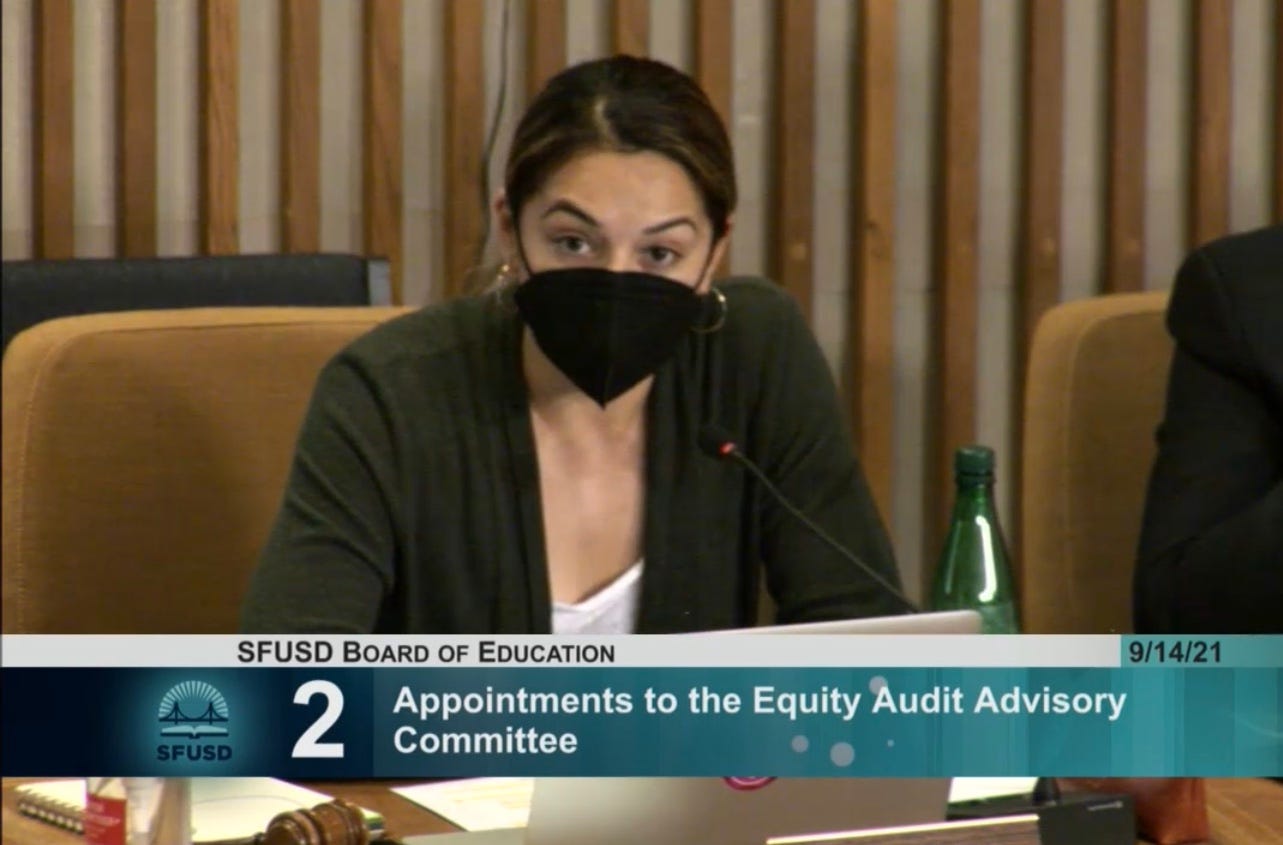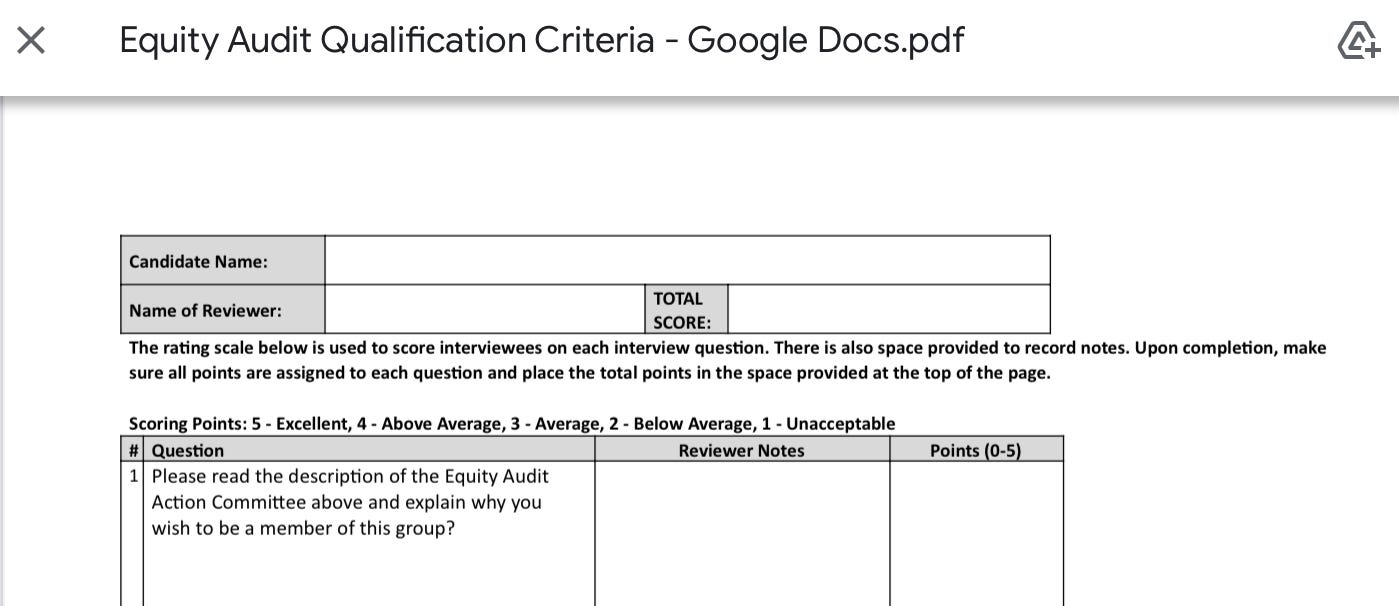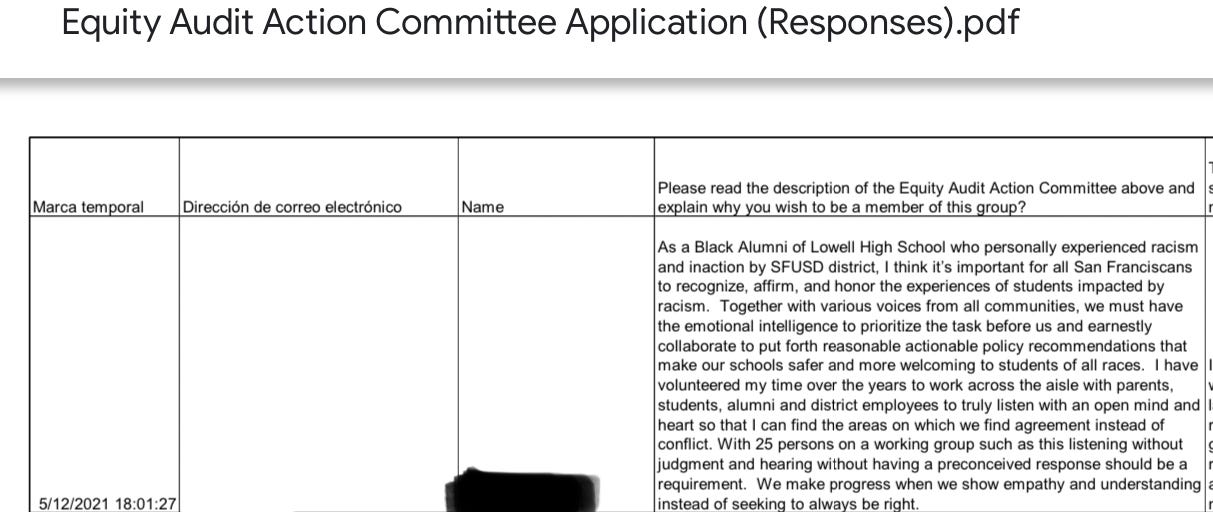López and Moliga Committee Selection sham is off the rails
Levels beyond egregious, breaking the Outrage Odometer
Internal San Francisco Unified School District (SFUSD) documents have revealed joint actions by the San Francisco Board of Education (SFBoE) President Gabriela López and Vice President Faauuga Moliga that have simultaneously gone against California state law, Board Procedure, and the black and white Resolution wording in selection of the Equity Audit Committee. These numerous abuses of procedure were duplicitously described as a sober selection under guise of some unstated rubric (1h46m timestamp). Repeated public questioning of the details of such advisory committee selections were blithely ignored by the rest of the SFBoE as they accepted such actions at face value, voting 7-0 in approval at the September 21, 2021 Special Meeting (50 minute timestamp).
It’s one thing to frequently use terms like “Equity” in campaigns and Resolution titles; it’s completely another thing to do the opposite of equitable work in the name of Equity. This Committee will review many schools in the District. A short list of some of the overtly questionable actions:
labeled potential committee members by their ethnicity and sexual orientation
accepted Committee members with no application answers
scored candidate responses in an unclear process called a rubric
rejected candidates of higher scores than those accepted
did not post extended application deadlines
did not post promised translated application forms
accepted Committee members who applied weeks late
did not follow Board Policy 1220: Citizen Advisory Committees
did not work with the Office of Racial Equity, San Francisco Human Rights Coalition, as stated in Resolution text
as such, violated the California state Brown Act, as the Resolution was not amended and public comment was about a Resolution not followed
diversity was described as part of the selection, but the term was not described consistently before hand, defined in any specific manner, or explained in how identification was determined
Figure 1: SFBoE Board President Gabriela López presents on Equity Audit Advisory Committee selection process, Regular Board Meeting September 14, 2021 (source: https://sanfrancisco.granicus.com/player/clip/39379?view_id=47&redirect=true)
The planned first meeting of this so-called Equity Audit and Action Committee meeting is November 3rd. The conscious joint actions of President López and Vice President Moliga are levels beyond egregious, even possibly breaking an Outrage Odometer.
Will the SFBoE Cure and Correct by withdrawing the Committee? Will the members of the Committee resign in protest? Will parents, students, teachers, administrators, and members of the public raise concerns? Will there be pyrocumulus clouds of suspicion about the entire audit process before the first meeting?
What we were told
At the September 14, 2021 Regular Board Meeting, Board President López stated, “… we acknowledge the call for transparency and clarity from the public from communities across the city and decided this was the best approach.” (emphasis mine). She continued:
“The five scale score rubric was used to rate the responses and names were omitted. We also wanted to ensure a diverse group was selected that incorporated the many perspectives and demands that were called for that brought this work to our district. This committee will include students, parents, district staff and community members and alumni. 20 have been chosen by the leadership of this board, and six additional spots will be for members of …[other groups as per the Resolution]. We received and continue to receive guidance from the University of Kentucky to support this process.”
In Commissioner discussions, López revealed that she and Moliga made the selection. She further stated that the agendized item was “an intensely intentional and supportive process” and was sharing clarity. At the same time, staff acknowledged that applications were never made translated in Chinese and Spanish as publicly promised multiple times in two May meetings of this year.
Moliga volunteered his assurance that the scrutinized selection process was proper:
“And, you know, I hear a lot of comments around, you know, access and trust. And just, you know, some folks, you know, talking about justice for overall, you know, groups that have been marginalized. And so I want to say myself, and in terms of selecting the committee, I do trust, and I feel like we had a pretty, pretty solid process in terms of vetting. And I'm confident in the process.”
Written description of that selection process was provided as an agendized item in the subsequent Special Board Meeting, September 21, 2021 (see figure).
Figure 2: Written description of the Equity Audit Committee selection process, as provided for the agendized item on Special Board Meeting, September 21, 2021.
Important to note the planned meeting for decision on this item was to be September 16, Yom Kippur. Public feedback engendered a rescheduling to September 21– a Jewish high holiday, the first full day of Sukkot.
Analysis of problematic processes
Reassured yet in the transparency and clarity?
Some of the problematic processes:
Board Policy 1220 on Advisory Committee selection is still followed routinely for positions on the Public Education Enrichment Fund Citizen Advisory Committee (PEEF CAC). For this Committee and for many others, following the policy appears optional. There are means for the SFBoE to amend Board Policies.
The Resolution 212-2A1 had wording that included working with the San Francisco Office of Racial Equity, a division of the SF Human Rights Commission to establish the “Community Commission” or Advisory Committee. Mention of involvement of this group was noticeably absent. Records from the Human Rights Commission confirm the distancing, perhaps in recognition that such efforts would sully their other work. Thus the SFBoE selection process was not following the Resolution and a violation of the California Brown Act. That was beautiful bait, but it’s now switched.
The stated procedure involved removing candidate names. At the same time, diversity was part of the selection. How were candidates identified? How was diversity defined? Was there background research performed on the candidates?
Where are the standards for the 5 point rubric? Educators can appreciate that rubrics can be applied well, if the rules are stated and examples modeled.
Lack of posting of application extension was acknowledged. Promises to do better in the future may help with future committees.
Lack of translated application forms were acknowledged many times by López and Commissioner Alison Collins, after repeated questioning from Commissioner Jenny Lam. Again, promises to follow procedure may help with future committees. For those who wanted to apply this time, clarity was absent.
Despite López’s claims, no guidance from the University of Kentucky was received from SFUSD records requests.
How’s that reassurance going?
How were they really chosen?
The English version of the application form is provided (Figure 3). There were three open-ended questions.
Figure 3: Application form for Equity Audit Committee
In response to records requests, this document (Figure 4) was the form SFUSD provided for records request for Committee candidate evaluation. Note the directions on how to score answers. One can imagine some leeway in how potential judges assign scores.
Figure 4: Equity Audit Committee candidate evaluation form provided by SFUSD in response to records requests. Scoring method detailed on this document.
Below are three lines from the spreadsheet of candidate responses (Figures 5-7). The spreadsheet appears generated from a Google forms protocol. The author knows of no macro which would remove the Candidate name or other cell or column or Google form entry from a populated spreadsheet. Email addresses (2nd column) appear manually obscured in the document provided. The names were obscured by the author after receipt from SFUSD.
Figure 5: Portion of a candidate application. How would you score this statement, 1-5?
Figure 6: Portion of another candidate application. How would the judges score this statement, 1-5?
Figure 7: Portion of a third candidate application. Note the timestamp is after the extended application deadline. Would the judges accept this candidate?
Results were assembled in one document with each candidate scored. A portion of this document is shown (Figure 8), with the score of one of the three candidates shown above. Email was obscured prior to receipt. Name was obscured by author.
Figure 8: Portion of Spreadsheet with Candidate scores. How was the member description made? Can you guess which of the above 3 candidates received 15 /15 points?
Questions:
How were the names obscured from the judges?
How was that scoring rubric applied on these candidates?
The first candidate above (Figure 5) received 15 points (Figure 8). Were the scores by the 2 judges averaged? There were no candidates with half a point, as would happen if the two judges gave scores that differed a point from each other. Were López and Moliga judging together?
The 2nd candidate (Figure 6) received a higher score than the 3rd candidate (Figure 7). Why was the 2nd candidate rejected?
The 3rd candidate (Figure 7) and others filed their applications after the extended deadline. How were they accepted?
How were the judges able to describe the race and sexual orientation and other descriptors of the candidates if the applicants did not provide such data? Hopefully there was no active candidate profiling happening.
At least two accepted Committee members had no applications on file. How were they scored and accepted?
This Equity Action work is already months behind the planned schedule. Even if the candidate judging were rushed, such numerous large errors are hard to explain. There is the possible explanation that the SFBoE do not care about following any procedure but instead make their own arbitrary choices to stack the Committee.
More records are expected from Kentucky. The state has a 3 day turn-around deadline. It’s been over a month since the request.











Excellent reporting! Heartfelt thanks for your hard work and dedication to the cause!